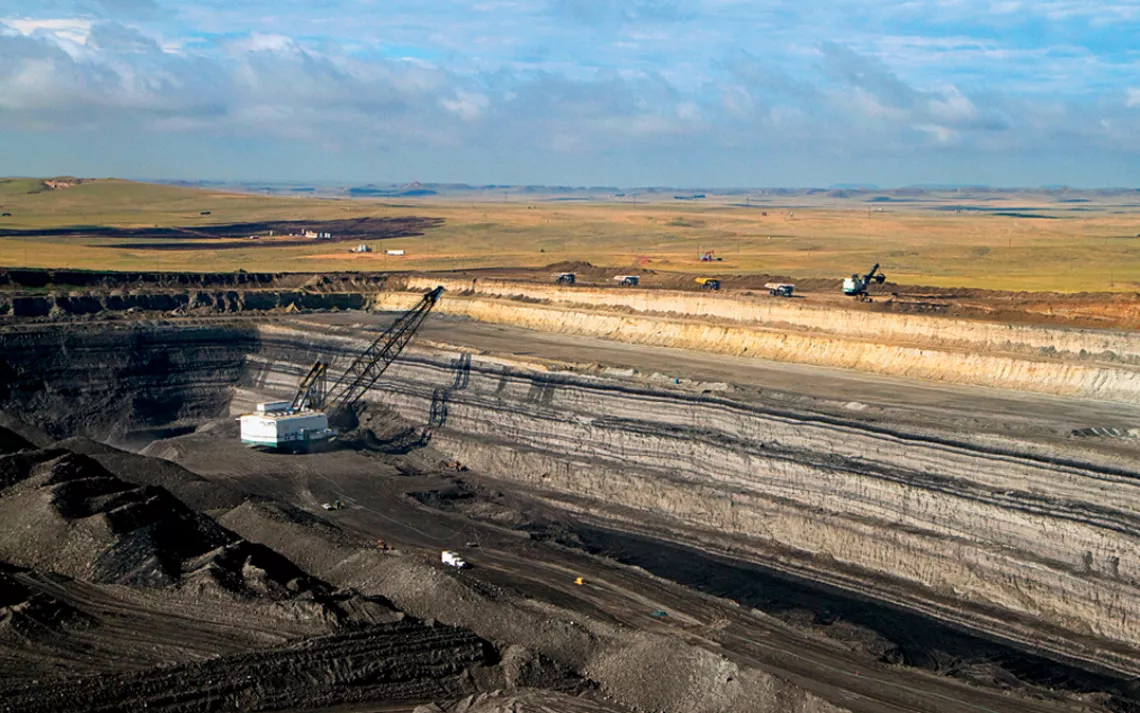Keep It in the Ground

Coal mines on public lands, like this one in Wyoming, account for 40 percent of U.S. coal production. | Photo by David R. Frazier Photolibrary, Inc./Alamy Stock Photo
In November, when President Barack Obama announced he was rejecting the Keystone XL pipeline, he used remarkably blunt language: “If we’re going to prevent large parts of this earth from becoming not only inhospitable but uninhabitable in our lifetimes, we’re going to have to keep some fossil fuels in the ground rather than burn them and release more dangerous pollution into the sky.”
Climate activists’ jaws dropped at President Obama’s invocation of the phrase “keep it in the ground,” which has become the new mantra of the climate movement. Only two months later, amazement changed to exultation when Secretary of the Interior Sally Jewell announced a three-year moratorium on all new and updated coal leases on federal land, during which the Bureau of Land Management will review the coal program’s environmental, economic, and health impacts. “We have an obligation to current and future generations,” Jewell said, “to ensure the federal coal program delivers a fair return to American taxpayers and takes into account its impacts on climate change.” It was the first time climate concerns had been cited by the government in connection with federal coal leases.
The idea of calling a halt to fossil fuel extraction received scientific backup from a 2015 study in the journal Nature, which found that in order to keep global temperatures from rising more than 2°C, 80 percent of the planet’s coal reserves, half of its natural gas reserves, and one-third of its oil reserves must remain unexploited. The idea gained traction as environmentalists, flushed with their victory over Keystone XL, adopted the “keep it in the ground” slogan as an organizing focus, realizing that reducing energy demand at home does nothing if we keep extracting our cheap-but-destructive fuels to export abroad.
The vast majority of federally leased coal comes from the Powder River Basin of Wyoming and Montana. It’s the nation’s single largest source of carbon pollution and the seventh largest on the planet. EcoShift Consulting has estimated that unleased recoverable coal there and on other public lands represents as much as 212 gigatons of potential carbon emissions. Yet the income the federal government receives from its coal leases doesn’t come close to covering their environmental cost. The climate change cost from mining and burning coal from the Powder River Basin, for example, is $62 per ton, while the coal itself sells for $13 per ton—only $1 per ton of which goes to the U.S. government in the form of royalties.
“The mentality that has driven federal energy policy has been to maximize production without factoring in economic or environmental costs,” says Matt Lee-Ashley, a senior fellow with the Center for American Progress. That may change now that the Interior Department plans to review the federal coal program for the first time in more than three decades. Charging energy companies leasing fees that reflect the full cost of carbon emissions would, economists say, effectively end leasing on federal lands.
The coal-leasing moratorium and review, however, is only a first step. Leasing for oil and natural gas on federal lands and waterways continues unabated; 34 million acres of public lands are already leased for those purposes. In November, Senator Jeff Merkley (D-Ore.) and six cosponsors attempted to forestall any future fossil fuel leases by introducing the Keep It in the Ground Act, which would stop new leases for coal, oil, gas, oil shale, and tar sands, and end nonproducing ones on all federal lands. The bill would also ban offshore drilling in the Arctic and Atlantic Oceans and halt additional leases in the Pacific Ocean and the Gulf of Mexico. If passed, the bill would keep about 450 billion tons of carbon pollution out of the atmosphere.
The legislation, however, is unlikely to get past the Republican-controlled Congress. Fortunately, the Obama administration has some other options at its disposal. The Department of the Interior has already been quietly putting regulations in place that would ratchet down the pace of extraction. At the same time, the Bureau of Land Management is looking into updating its royalty rates for oil and gas leases, and both the EPA and the BLM are writing regulations aimed at reducing emissions from the venting and flaring of methane on public lands.
Climate activists are keeping up the pressure by showing up en masse at BLM lease sales across the country. For example, last November, the BLM was forced to delay a Salt Lake City oil and gas lease auction of 37,580 acres of public land in Utah, citing the “high level of public interest in attending the sale.” The number of expected protesters exceeded the auction room’s seating capacity.
Bringing federal leasing policy in line with the nation’s climate change goals won’t happen overnight, or even in what remains of President Obama’s second term. But the “keep it in the ground” movement has already succeeded in reframing the conversation. In January’s State of the Union address, President Obama vowed to “change the way we manage our oil and coal reserves, so that they better reflect the costs they impose on taxpayers and our planet.” Suddenly, the president is climate activist in chief.
WHAT YOU CAN DO
Senator Jeff Merkley has introduced the Keep It in the Ground Act, which would halt new leases for coal, oil, and gas on public lands and bar the extension of nonproducing existing leases. This important legislation provides a road map for stopping fossil fuel extraction. Urge your senators to cosponsor the bill by signing the petition at sc.org/intheground.
 The Magazine of The Sierra Club
The Magazine of The Sierra Club



